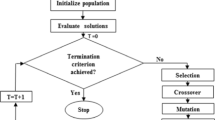Abstract
Finding optimal solutions of a numerical function of more than one independent variable is an important problem with many practical applications including process control systems, data fitting, and engineering designs. Over the last few decades, techniques for solving unconstrained optimization problems have been proposed. Evolutionary Algorithms have emerged as one of the most popular selections for tackling these problems, among which Genetic Algorithms (GAs) are widely used in practice. In recent literature on GAs, a Genetic Algorithm with multi-parent crossover (GA-MPC) was found to be superior over other algorithms. Nevertheless, the GA-MPC still has some difficulties when dealing with separable test issues and convergence to global optima in the high-dimensional search space. Meanwhile, quaternions, which are an extension of complex numbers, can allow algorithms to expand the search space to avoid getting stuck in the local optima. Therefore, this study aims to employ quaternions for representing individuals in the GA-MPC to enhance the effectiveness of the GA-MPC. Experimental results for ten benchmark functions indicated that the GA-MPC using the quaternion representation of individuals improved the quality of solutions compared with the original GA-MPC.

Similar content being viewed by others
References
Yang XS (2008) Nature-Inspired Metaheuristic Algorithms. Luniver Press
Ono I, Kita H, Kobayashi S (2003) A real-coded genetic algorithm using the unimodal normal distribution crossover. Springer, New York, pp 213–37
Dennism JE Jr, Schnabel RB (1989) A view of unconstrained optimization. Handbooks in Operations Research and Management Science 1:1–72
Russell SJ, Norvig p (2003) Artificial Intelligence: A Modern Approach. Pearson Education
Darwin C (2009) The origin of species, 6th edn. Cambridge University Press
Kennedy J, Eberhart RC, Shi Y (2001) Swarm intelligence. Morgan Kaufmann, San Francisco
Elfeky E, Sarker R, Essam D (2008) Analyzing the simple ranking and selection process for constrained evolutionary optimization. J Comput Sci Technol 23(1):19–34
Deb K, Anand A, Joshi D (2002) A computationally efficient evolutionary algorithm for real-parameter optimization. Journal of Evolutionary Computation 10(4):371–95
Higuchi T, Tsutsui S, Yamamura M (2000) Theoretical analysis of simplex crossover for Real-Coded genetic algorithms. Springer, Berlin, pp 365–74
Elsayed SM, Sarker RA, Essam DL (2014) A new genetic algorithm for solving optimization problems. Eng Appl Artif Intell 27:57–69
Hamilton WR (1844) On Quaternions, or on a New System of Imaginaries in Algebra. Phil Mag 25(3):489–95
Fister I, Yang X-S, Brest J, Fister I Jr (2013) Modified firefly algorithm using quaternion representation. Expert Syst Appl 40(18):7220–7730
Girard PR (2007) Quaternions, Clifford Algebras and Relativistic Physics. Birkhäuser, Basel
Via J, Ramirez D, Santamaria I (2010) Properness and widely linear processing of quaternion random vectors. IEEE Trans Inf Theory 56(7):3502–15
Xu Y, Yu L, Xu H, Zhang H, Nguyen T (2015) Vector sparse representation of color image using quaternion matrix analysis. IEEE Trans Image Process 24(4):1315–29
Garey MR (1979) Computers and Intractability: A Guide to the Theory of NP-Completeness. W.H. Freeman
Eiben AE, Smith JE (2003) Introduction to Evolutionary Computing. Springer
Ventura S, Luna JM (2016) Pattern Mining with Evolutionary Algorithms. Springer
Beyer HG, Schwefel HP (2002) Evolution strategies - a comprehensive introduction. Natural Computing: an international journal 1(1):3–52
Fogel LJ, Owens AJ, Walsh MJ (1966) Artificial intelligence through simulated evolution. Wiley, Chichester
Koza JR (1992) Genetic Programming: On the Programming of Computers by Means of Natural Selection (Complex Adaptive Systems), 1st edn
Banzhaf W, Francone FD, Keller RE, Nordin P (1998) Genetic programming: an introduction on the automatic evolution of computer programs and its applications. Morgan Kaufmann, San Francisco
Mitchell M (1996) An introduction to genetic algorithms. MIT press, Cambridge
Yu X, Gen M (2010) Introduction to Evolutionary Algorithms. Springer
Affenzeller M, Winkler S, Wagner S, Beham A (2009) Genetic Algorithms and Genetic Programming: Modern Concepts and Practical Applications, 1st edn. Chapman & Hall/CRC
Koza JR, Andre D, Bennett FH, Keane M (1999) Genetic Programming 3: Darwinian Invention and Problem Solving. Morgan Kaufman
Freitas AA (2002) Data Mining and Knowledge Discovery with Evolutionary Algorithms. Springer, Berlin
Reina DG, Ruiz P, Ciobanu R, Toral SL, Dorronsoro B, Dobre C (2016) A survey on the application of evolutionary algorithms for mobile multihop ad hoc network optimization problems. International Journal of Distributed Sensor Networks - Special issue on Computational Intelligence in Wireless Sensor and Ad Hoc Networks 2016:2082496:1-2082496:13
Picek S (2015) Applications of evolutionary computation to cryptology. PhD Thesis, Radboud Universiteit, Nijmegen
Yang X-S (2010) A new metaheuristic Bat-Inspired algorithm. Springer, Berlin, pp 65–67
Karaboga D, Basturk B (2007) A powerful and efficient algorithm for numerical function optimization: artificial bee colony (ABC) algorithm. J Glob Optim 39(3):459–71
Boyer DO, Martinez CH, Pedrajas NG (2005) CIXL2: A crossover operator for evolutionary algorithms based on population features. J Artif Intell Res 24:1–48
Friedman M (1937) The Use of Ranks to Avoid the Assumption of Normality Implicit in the Analysis of Variance. J Am Stat Assoc 32(200):675–701
Demsar J (2006) Statistical comparisons of classifiers over multiple data sets. The Journal of Machine Learning Research 7:1–30
García S, Fernández A, Luengo J, Herrera F (2010) Advanced nonparametric tests for multiple comparisons in the design of experiments in computational intelligence and data mining: Experimental analysis of power. Inf Sci 180(10):2044– 2064
Iman RL, Davenport JM (1980) Approximations of the critical region of the Friedman statistic. Communications in Statistics: A Theory and Methods 9(6):571–95
Sheskin DJ (2004) Handbook of Parametric and Nonparametric Statistical Procedures, 3rd edn. Chapman & Hall/CRC
Holm S (1979) A simple sequentially rejective multiple test procedure. Scand J Stat 6:65–70
Author information
Authors and Affiliations
Corresponding author
Rights and permissions
About this article
Cite this article
Khuat, T.T., Le, M.H. A genetic algorithm with multi-parent crossover using quaternion representation for numerical function optimization. Appl Intell 46, 810–826 (2017). https://doi.org/10.1007/s10489-016-0867-y
Published:
Issue Date:
DOI: https://doi.org/10.1007/s10489-016-0867-y




